I began this blog back in early March and finished about 70% of it by mid-March. For various reasons, mainly work commitments and laziness, it has since lain dormant gathering cyberspace dust. Anyway, I have finally got around to finishing it – I suppose better late than never. It is long but that reflects the many different destinations we visited and the numerous photo opportunities that we were presented with.
In February I was back in Japan for my annual Hokkaido winter wonderland sojourn. Normally I’ve made this trip alone or with just two or three guests. This time I co-led a group of seven photographers along with legendary bird photographer, Arthur Morris and the hyper-creative, Denise Ippolito. When you accompany other photographers you never quite know what you are going to get but I am happy to report that the group turned out to be just about perfect – some of the nicest people you could possibly hope to meet. I love Japan’s culture but for those visiting Japan for the first time, elements of it can be frustrating and challenging. Fortunately everyone coped well and for the most part fully embraced the culture. The absence of dramas on this front was mirrored in the trip’s logistics – a good job since this was my primary responsibility. To be fair, this would not have been possible without the standing and connections of our Japanese guide and host in Hokkaido. This ensured that we had maximum flexibility in what and where we photographed, something that other photographic groups almost certainly do not have, despite what they may tell you. He and his wife have also become good friends; this being the fifth year that I have worked with them. A special shout-out must go to Shinobu for her incredible cuisine. Despite the far reaching dietary requirements of some of our party, Shinobu never ceased to amaze with her incredible culinary skills.
The Japanese are often sticklers for detail and tradition and this can sometimes lead to inflexibility and an inability to see the woods from the trees (I should add that this certainly does not apply to our hosts). But this is all overshadowed by their unfailingly charming hospitality; unrivalled politeness; mouth-watering food and presentation and for photographers, breathtaking scenery and a smorgasbord of superb wildlife.
Flight of the eagles
After overnighting in Tokyo, we flew to south-eastern Hokkaido, drove to our ideally located lodging (none of the soulless budget hotels that some other groups stay at) and were photographing within an hour. On the first afternoon we concentrated on White-Tailed Eagles and Black Kites which are attracted to a daily fish feeding. Although not my favorite location owing to the crowds of photographers that gather here, there’s no denying that if you want nice images of the eagles in flight, this is the place to go.
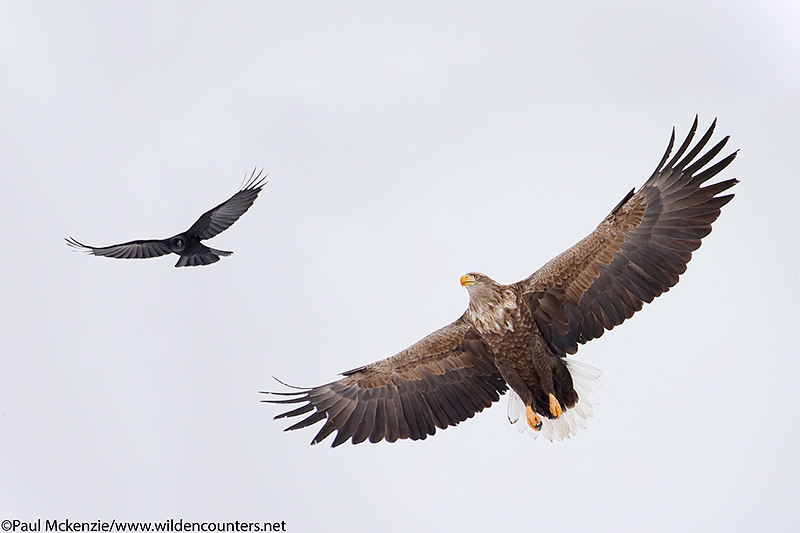
White-Tailed Eagle and Crow in flight, Eastern Hokkaido, Japan

White-Tailed Eagle about to snatch fish, Eastern Hokkaido, Japan
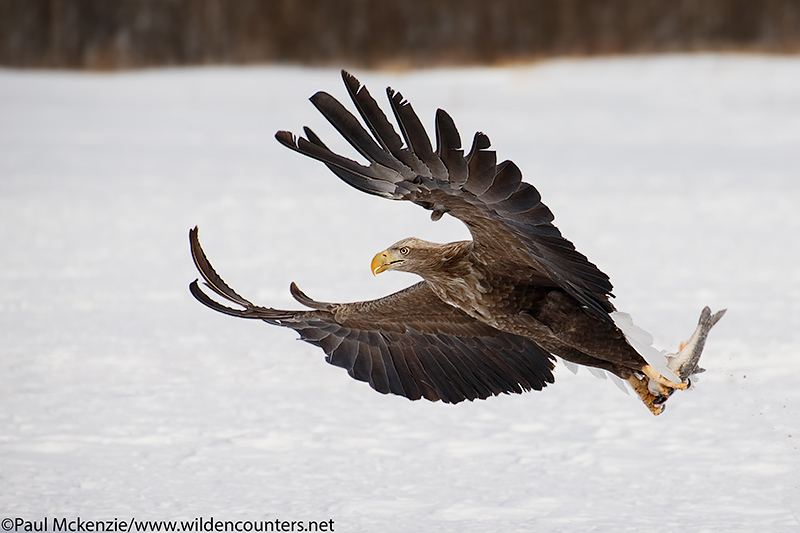
White-Tailed Eagle snatching fish, Eastern Hokkaido, Japan
The crane attraction
For anyone visiting Eastern Hokkaido in winter, there’s no question that the prime attraction has to be the courting Red-Crowned Cranes. Once thought to be extinct in Japan due to demand for their feathers, they have been nursed back from the brink helped by conservation efforts and grain feeding during the winter months such that their numbers are now up to 1,200. So emblematic and charismatic are the birds, known locally as tancho, that they have become a national symbol in Japan. All are resident in a small area in eastern Hokkaido. For most of the year they are hidden deep within marshland but for two months in winter, they emerge to a few select snow-covered fields where they forage for grain and perform spectacular courtship dances. In the same vain as Albatrosses which have also perfected ritualized dancing, the poetic displays by the cranes are of special significance as they also mate for life. The atmosphere and mood from a photographic standpoint at the crane fields can change dramatically depending on the weather conditions and falling snow is the perfect ingredient. In contrast to the main Japanese Island of Honshu further south, this year has seen unusually light snowfalls in Hokkaido, leaving many of its undulating hills, normally blanketed in deep powder, bereft and brown. For the week prior to arriving in Japan, I would scan the weather forecast every day only to see nothing but fine weather forecast – not just for a few days but for two straight weeks. However, on the day before departure, a forecast for a few cms of snow began to appear about 4 days into our trip. As this day approached the magnitude of the predicted snow fall began to build until a substantial 16cms was forecast over a 24 hour period. We woke on the morning of the 16th to find white-out conditions, with all the roads closed. Given our lodge’s proximity to the main Crane field, this wasn’t a problem for us and for much of the day we had the luxury of the photography perimeter almost entirely to ourselves. The Cranes not surprisingly, were late in leaving their overnight roosts on the nearby rivers but slowly they began to arrive along with a handful of Whooper Swans. Initially it was hard to discern whether any birds had actually arrived given the white-out conditions and it is a wonder that I managed to make this next image when you see the raw file, an unaltered jpg of which I have provided below.

Red-Crowned Cranes in snow blizzard, Eastern Hokkaido, Japan

Raw file of the previous image!
Some of the credit must go to the amazing auto-focus capabilities of the Canon 1DX, which I had splashed out for prior to this trip. For a number of years I have been perfectly happy with my 1D MK4, used in conjunction initially with the 5D MK2 and then later with the MK3. The 1D MK4 is a fine camera but the 1DX is on a completely different level. The blazingly fast frame rate with a buffer that never seems to fill regardless of the number of frames one shoots in a single burst, is an obvious attraction. However, it is the autofocus, long an issue in previous Canon DSLRs, that really elevates this camera. It is soooo good. Often I used it with all 61 focus points activated and the number of out of focus images was so low as to be almost ridiculous. It’s ability to pick up contrast even when the human eye is struggling can be illustrated in the two images above.
While heavy snow continued to fall, the visibility gradually lifted and the next image was taken about 45 minutes after the ones above.
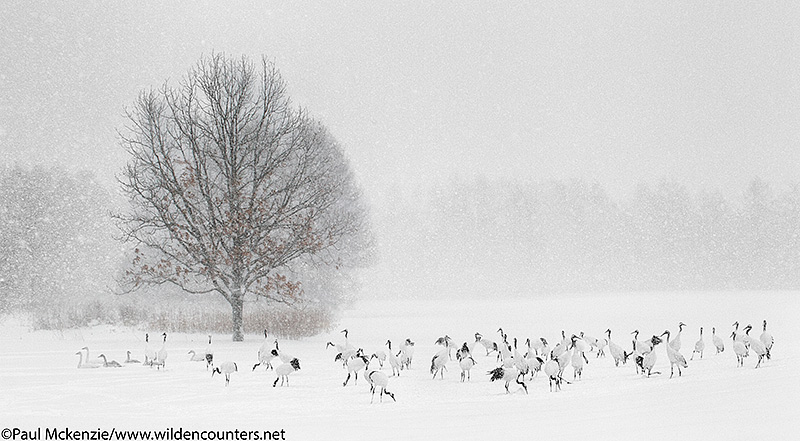
Red-Crowned Cranes and Whooper Swans feeding as snow falls, Eastern Hokkaido, Japan

Red-Crowned Cranes walking over the crest of an undulating snow-covered field as snow falls, Eastern Hokkaido, Japan
What everyone wants though are the dancing Cranes. However, seeing the Cranes dance and actually making pleasing images, are quite far removed from each other. For starters, the dancing happens very sporadically. An hour or even longer can go by with minimal activity. Then suddenly, one pair will go at it and this seems to trigger other pairs leading to a short burst of frantic activity. More often than not though, the dancing pairs are annoyingly obscured or partly so by other Cranes and achieving separation is a major challenge. Then there is the issue of the background, which on clear days provides few windows of relatively uniform, blurred backdrops. Knowing where to stand helps as is a little luck in terms of getting an eye-level view of the Cranes without the horizon level cutting through the birds – a big pet peeve of mine. But what you really need are days of low visibility and this typically only occurs when it snows. The 16th of February provided near perfect conditions for this.

Red-Crowned Crane courtship dance, Eastern Hokkaido, Japan

Red Crowned Crane courtship dance, Hokkaido, Japan
In the afternoon, the snow eased off and visibility increased bringing the background into play. But with continued nice dull light and periodic bouts of frantic dancing, there were still plenty of photo opportunities.

Red Crowned Cranes courtship dance #3, Hokkaido, Japan
I have lots of Crane portrait shots taken over the years but I rarely process any on the grounds that they’re easy to take and everybody else has them, but this one, using a high-key technique where you deliberately over-expose the image (taught to me a few years ago by Artie), kind of appeals to me.
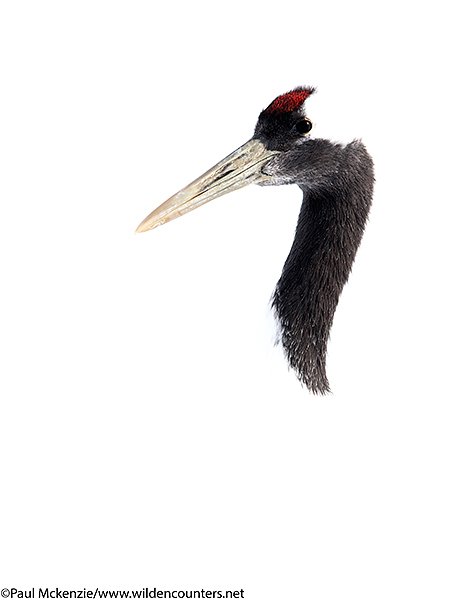
Red-Crowned Crane portrait, high-key, Hokkaido, Japan
Fast shutter speed images of Cranes flying sort of fall into the same category as portraits – they don’t really rock my boat. But I will make a few exceptions for instance where the birds are flying and landing in falling snow…

Red-Crowned Crane landing on snow-covered field as snow falls, Hokkaido, Japan
…or where there is an interesting flight pose or angle…
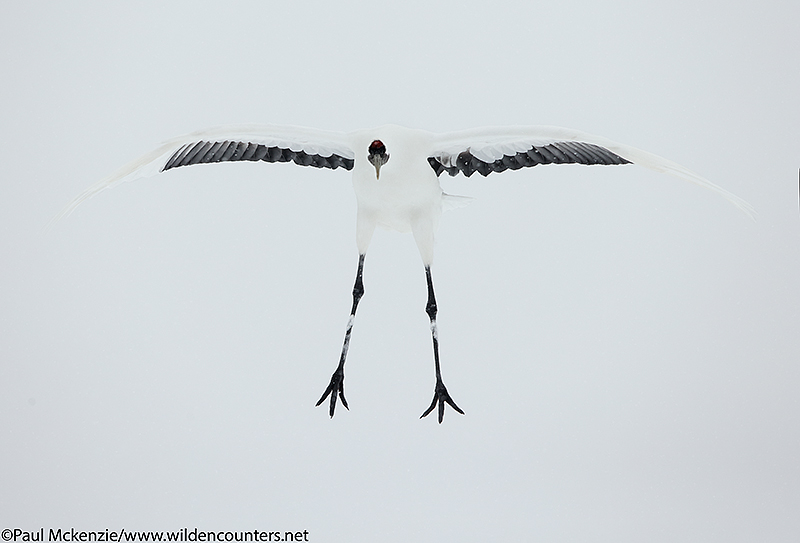
Red-Crowned Crane coming into land, Hokkaido, Japan
…and this next one which given the busy background, would normally go straight to the trash can. However, somehow the combination of the orange leaves and the monochromatic tones throughout the rest of the image serve to give this a Japanese painterly feel.

Red-Crowned Crane flying past tree, Hokkaido, Japan
But I much prefer flight images which show motion, usually achieved by panning and slowing down the shutter speed. Not only are they more aesthetically pleasing, but when one is using shutter speeds of 1/20th second or less, they are harder to take when the goal is to try and get a reasonably sharp head. It’s always more rewarding when one of these types of images works vs the easy, sharp, fast shutter speed flight shot.
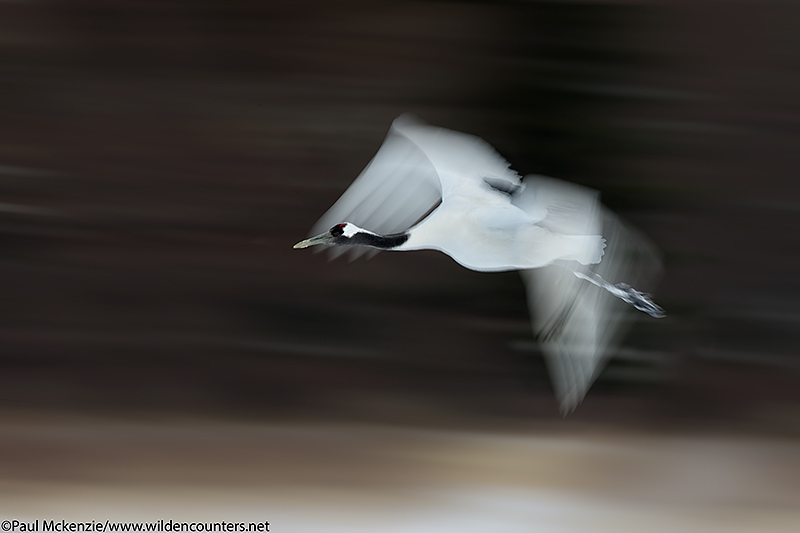
Red Crowned Crane flying, with motion, Hokkaido, Japan
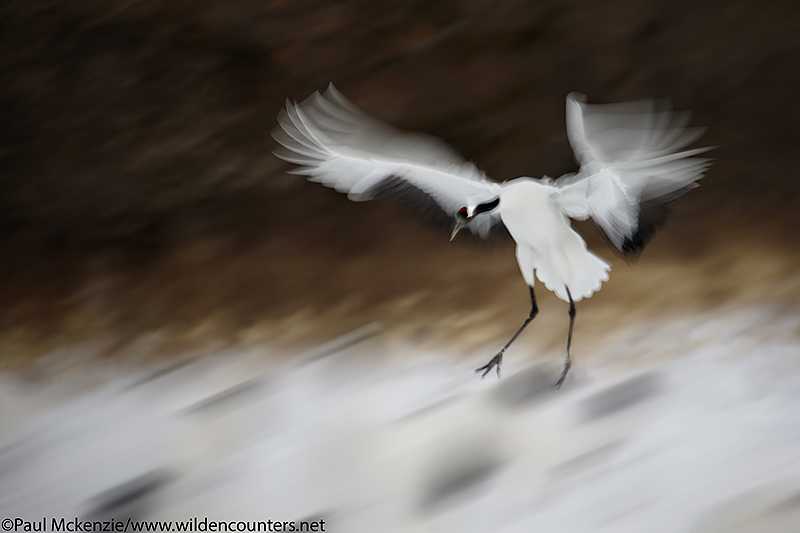
Red-Crowned Crane landing, with motion, Hokkaido, Japan
And sometimes even crazy images can work. Here I was set up to shoot with a slow shutter speed and I continued to pan and shoot even when the birds flew behind the trees. Again, you have to wonder how the camera held focus!
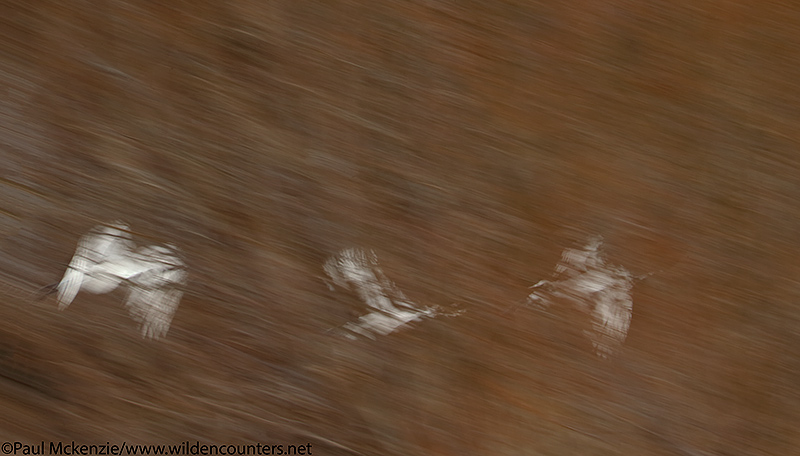
Red-Crowned Cranes flying behind trees, with motion, Hokkaido, Japan
Swan Lake
My favorite destination in Eastern Hokkaido is Lake Kussharo. When we took a poll at the end of the trip on participants’ most and least favorite site, Lake Kussharo scored lowest or close to the bottom of the list on almost everyone’s list apart from mine. I still can’t quite figure this out. Maybe it was because everyone is attracted to the large iconic Cranes and Sea Eagles or maybe it was because I was the only participant who given a choice, will always shoot wide-angle before telephoto. This is an important consideration because while the Whooper Swans are pretty enough, it is the backdrop that is the big attraction and to capture this you need to be shooting fairly wide or at least with a shortish zoom lens. I certainly would have preferred to spend more than a day and a half at the lake but we were still blessed with great photo opportunities. We stayed away for the most part from the most popular site along the lake instead focusing on various lesser known ones. For one of these, I have never encountered a single other photographer in five years of travelling to Lake Kussharo. On the first morning while the rest of the group were enjoying spectacular opportunities at one of my favorite sites, I went off on my own to quickly reconnoiter my go-to early morning destination. This is very much a wide-angle site and I always try to capture the mix of solitude and frozen silence with a Japanese twist – provided by the overhanging tree branches. I also prefer to leave the cool blue tones of the scene intact.

Whooper Swan at dawn, Lake Kussharo, Japa
In the evening, I took the group to another of my favorite spots, which we again had to ourselves. I have experienced all sorts of weather conditions here but in the late afternoon, we were blessed with a beautiful sunset with the colours reflected on the frozen lake opening. Five-stops of graduated neutral density helped to balance the foreground and background lighting differences.

Whooper Swan on frozen lake opening, Lake Kussharo, Hokkaido, Japan
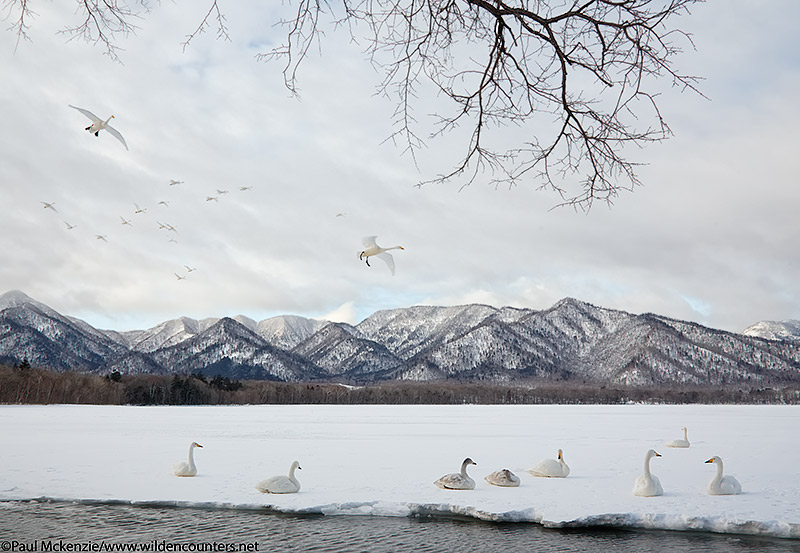
Whooper Swans landing on frozen lake, Lake Kussharo, Hokkaido, Japan
I didn’t completely abandon my long lenses. This is with the 600mm and the 2x. A nice image that is all about the curve of the neck.

Whooper Swan close-up, Lake Kussharo, Hokkaido, Japan
It is in these sorts of situations that Artie Morris really comes into his own. He has one abstract-like image of the top of a Swan’s head with tufted orange-tinged feathers that is absolutely killer and in my book, a guaranteed contest winner.
Minimalistic landscapes
With the fixation on the admittedly spectacular wildlife, many groups overlook Eastern Hokkaido’s dreamy landscapes. Because of the paucity of snow, landscape photography was more challenging this year but with patience and a few trained eyes, we were able to ferret out a few good possibilities. As I have written before, it is very hard not to be influenced by the stark, minimalistic style landscapes made famous by Michael Kenna. This first image could easily have come from him. The difference of course is that his (small-sized) gallery prints sell for several thousand dollars.
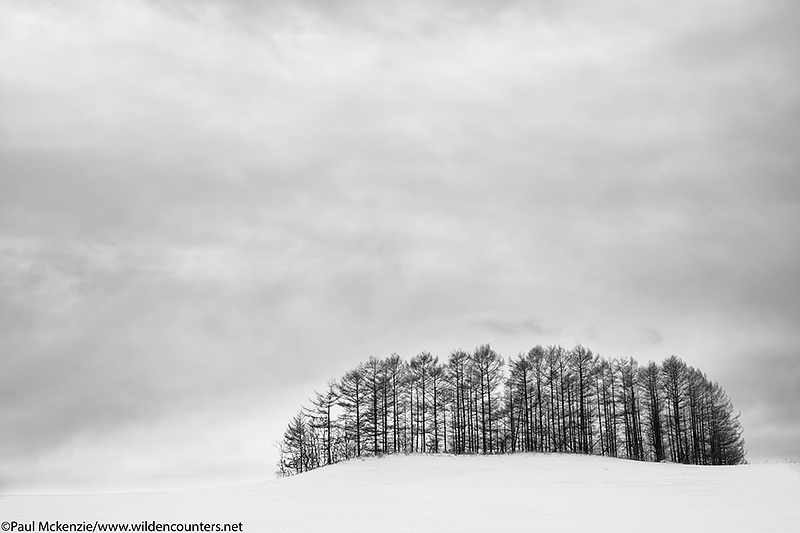
Larch trees, Eastern Hokkaido, Japan
The focus doesn’t just have to be on isolated trees, appealing as these are. While photographing one of my favorite groups of trees, I notice this fence some distance away. I walked a long way around the two accessible sides of the fence but could never quite find the right perspective I was looking for – hence my decision to settle for a square crop.

Fence on sloping snow-covered field, Eastern Hokkaido, Japan
Pack-ice wonders
After the Swans , we journeyed to our next destination and for some in the group, the blue-ribbon species of the trip: Steller’s Sea Eagles. This eagle, with its large distinctive orange bill, is the heaviest eagle on our planet and second only to the Harpy and Philippine Eagle in size. In February and parts of March, they gather in large numbers on the pack ice in the Sea of Okhotsk, near to the fishing port of Rousu on the Shiretoko Peninsular, attracted to regular fish feeding, for the benefit in part, of photographers. When conditions are right, the snow covered, forested mountains behind the fishing port provide a beautiful backdrop for the Stellers which are joined by even greater numbers of White-Tailed Eagles.

Steller’s Sea Eagles and White-Tailed Eagles on pick-ice outside of the port of Rausu, Hokkaido, Japan
One of the problems with taking images from a largish boat in these conditions is that you are usually looking down at the pack-ice, which tends to be cluttered and interspersed with pockets of water. Hence, unless you are shooting wide-angle or very tight with long telephoto lenses, you can end up with unattractive backgrounds. I am always on the look-out for small ice pinnacles which the birds will often use as perches. Since even these are of limited elevation, I try to get as low on the deck as possible to create a clean background. The other point is to anticipate the action. An empty pinnacle will invariably attract an Eagle. It is usually easier to pre-focus on the pinnacle and wait for the bird to arrive. Since I can’t be sure the bird will arrive parallel to the camera, I don’t however, like to rely on manual pre-focus. Instead I pre-focus but stay in auto-focus and rely on all 61-points of the 1DX to pick-up the action.
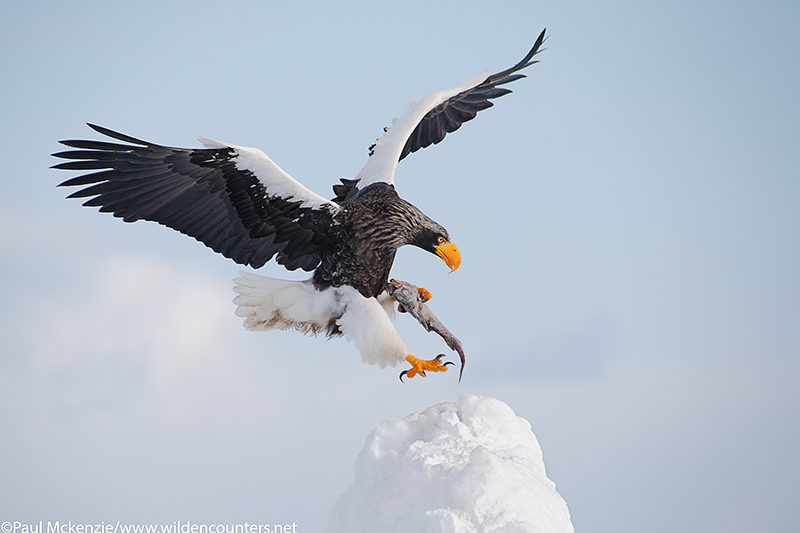
Steller’s Sea Eagle with fish, landing on pack ice pinnacle, Sea of Okhotsk, Hokkaido, Japan
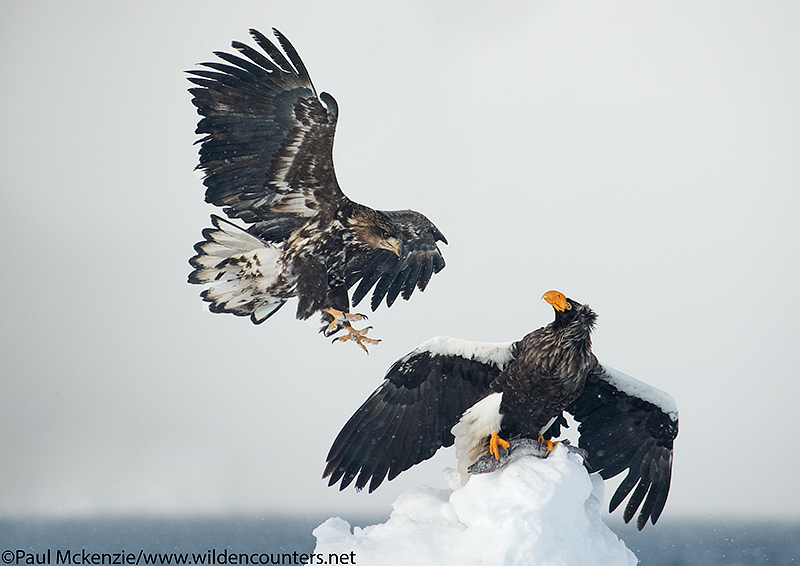
Adult Steller’s Sea Eagle perched on pack ice pinnical holding fish as a juvenile approaches, Sea of Okhotsk, Hokkaido, Japan
On our last morning out on the pack-ice, the crew left an exposed crate of frozen fish out on the foredeck for a few minutes. This quickly attracted a veritable army of hungry gulls, mainly Slaty-Backed and Glaucous-Winged. At times it looked like a scene out of a Hitchcock movie (without the human gore). Seeing an opportunity I quickly switched to a fish-eye lens shooting at almost point-blank range. You need to take a lot of frames in the hope that in one or two you will have some degree of separation between the gulls.
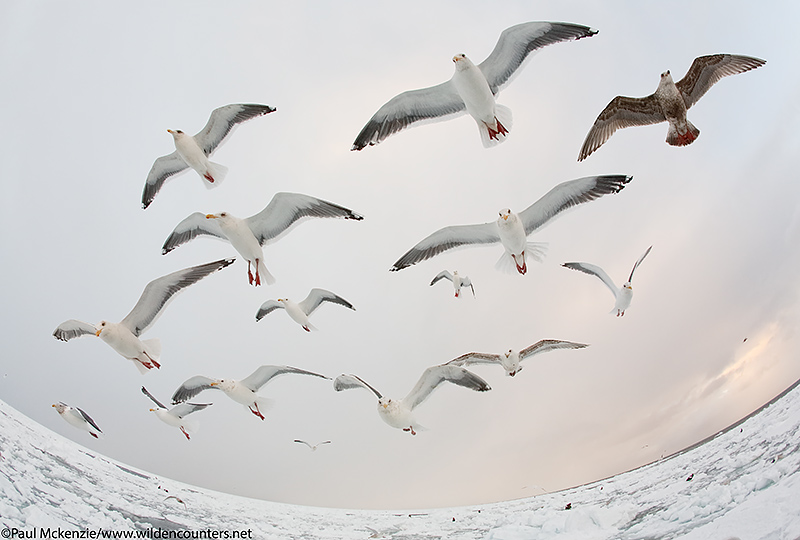
Fish-eye view of Slaty-Backed and Glaucous-Winged Gulls over the pack-ice, Sea of Okhotsk, Hokkaido, Japan
Monkey business
And so it was goodbye to Hokkaido for another year. Instead of going home, this year I was continuing on with the group to the Japanese Macaques, commonly known as Snow Monkeys, in Central Honshu. I first visited these charismatic monkeys in 2008 and have since been back in all but one of the subsequent years. The monkeys themselves probably don’t justify such regular trips but it is the combination of the charming ryoken that I stay at with its incredible food and a choice of 11 separate indoor and outdoor onsens that is just as much a draw card. That and the fact that it’s relatively easy to get to from Hong Kong.
Anyway, this year I had previously made an additional trip in January with my wife and daughter. In part this was to set up everything for the group in February but also because in January, you have a much better chance of falling snow. The following images are a tiny selection of those that I took over the two trips but I certainly had better opportunities on the first trip, helped by the weather with one of the days seeing heavy snow fall.
When one goes to Jigokudani, it’s important to bring a few different lenses in order to shoot a variety of images. The following were shot with a 16-35mm, a 24-105mm, a 70-200mm (sometimes with a 1.4x TC) and a 100mm macro. Most were also made with a little fill flash. Some nature photographers don’t like using fill flash but with light levels often low, I find a little fill flash really helps to bring out the details in the wonderfully expressive faces of the monkeys. Most photographers understandably spend most of their time photographing the monkeys in the outdoor onsen but there are always opportunities in some of the neighboring areas.
The first two images were taken in almost the same spot but the first one was taken at the end of February and the second in mid-January. Note the differences in snow cover. This year was unusual insofar as the first half of February saw two large snowfalls, the first one of which dumped so much snow on the area that the park was closed for three days.
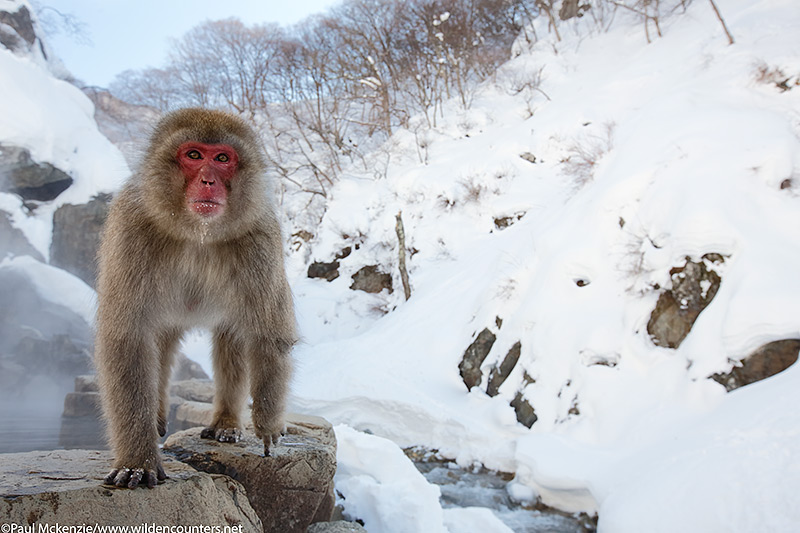
Japanese Macaque standing on the edge of outdoor hot spring, Jigokudani, Japan
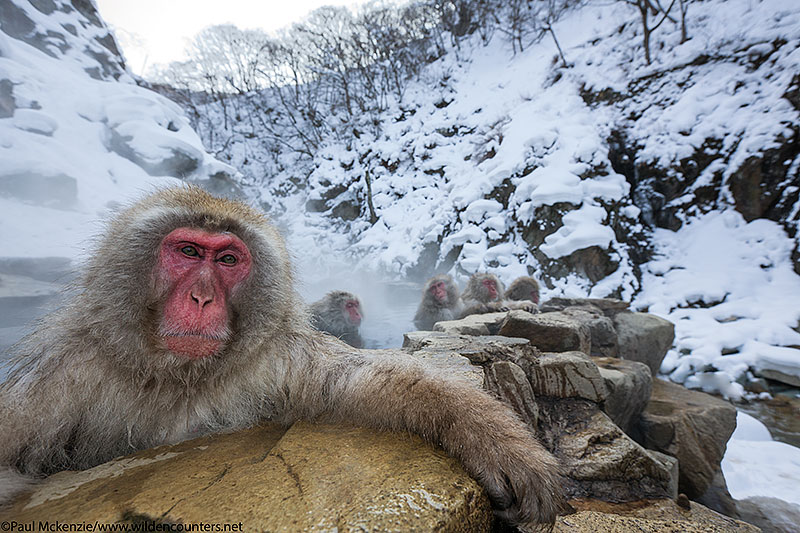
Japanese Macaque in outdoor hot spring, Jigokudani, Japan
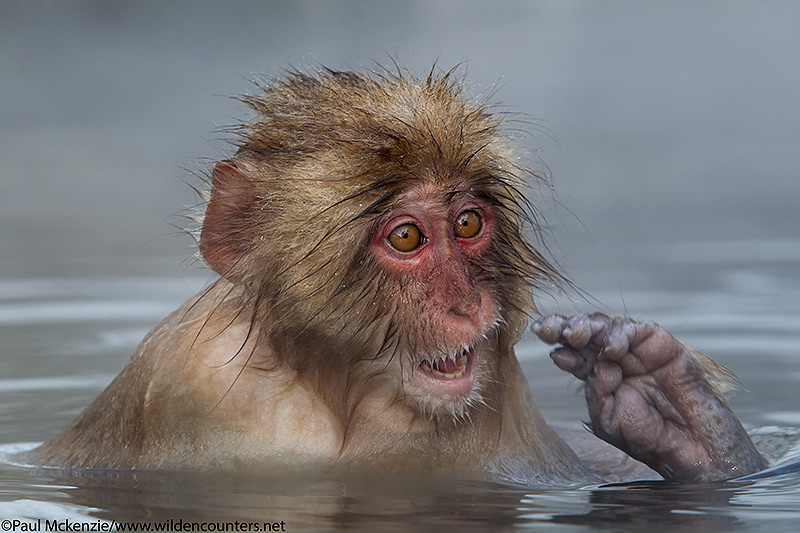
Juvenile Japanese Macaque in outdoor hot spring, Jigokudani, Japan
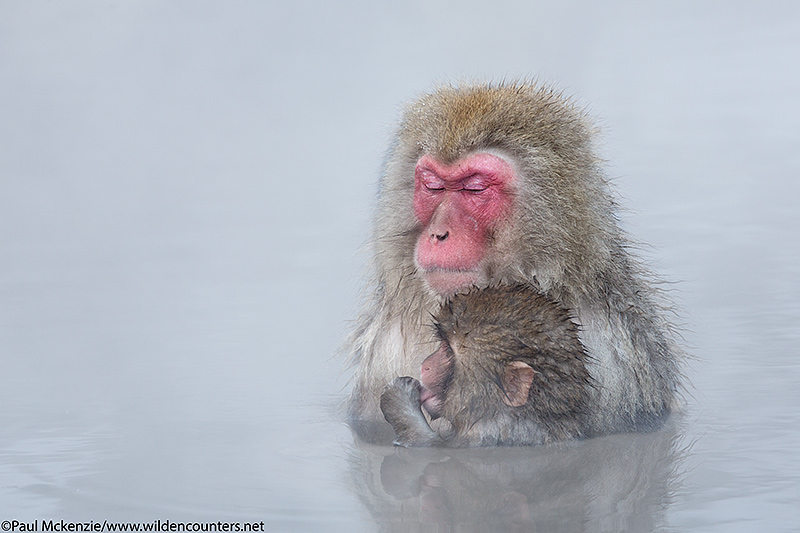
Adult and juvenile Japanese Macaque in outdoor hot spring, Jigokudani, Japan
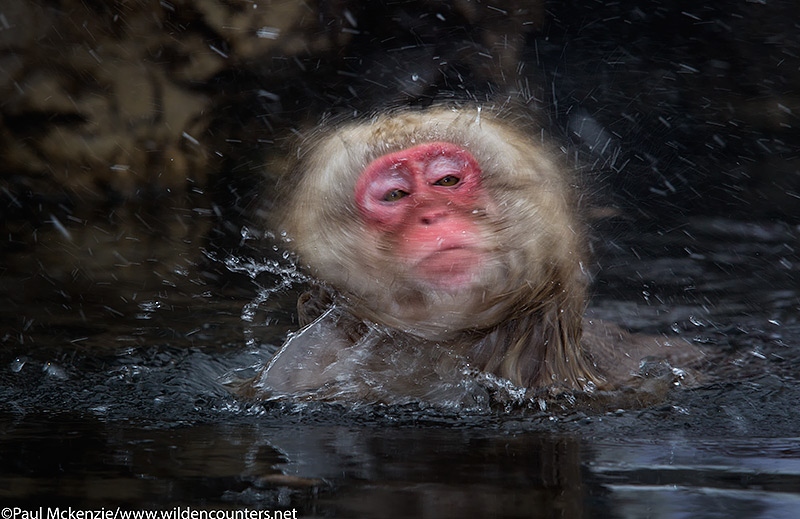
Japanese Macaque shaking its fur of snow and water in outdoor hot spring, Jigokudani, Japan

Japanese Macaque standing in the snow, Jigokudani, Japan

Japanese Macaque running through snow, Jigokudani, Japan
OK this next image might look slightly familiar and there’s no question that it was inspired by Jasper Doest’s wonderful image from a few years ago which garnered many awards. Jasper’s image has the eyes shut to highlight the eye-shadow like colouring of the eyelids. This one has the eyes open and you can see the use of flash to open up the shadows. I used a 70-200mm lens with 25mm of extension tube to enable closer focusing.

Japanese Macaque face close-up with head fur covered in snow, Jigokudani, Japan
The monkey’s faces are incredibly photogenic; not just for their myriad of expressions but also for their rich colouring.

Adult Japanese Macaque. sleeping, portrait, Jigokudani, Japan
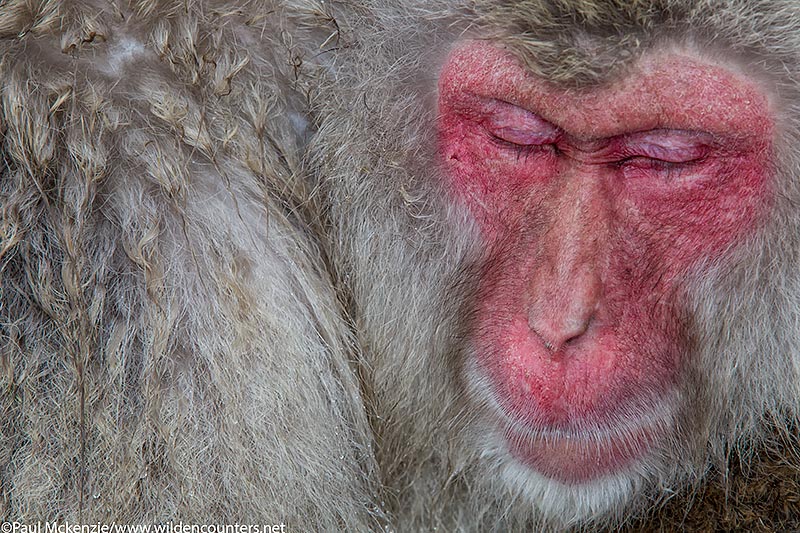
Japanese Macaque sleeping, Jigokudani, Japan
The next image was taken with a macro lens with the emphasis on the water droplets on the whiskers.

Japanese Macaque mouth and nose close-up, Jigokudani, Japan
A narrow but fast flowing river flows through Jigokudani and the Monkeys will sometimes leap across it. Unfortunately in the last year, the park staff have built a small wooden bridge which the clever monkeys now largely use, in turn restricting natural crossings (imagine if they built bridges across the Mara River for the Wildebeest and Zebras to use during their migration). Anyway, a friendly group of South African photographers received permission to temporally block the bridge, thereby necessitating a return to natural crossings. With lots of rocks in the river and with the opposite river bank coming into play from most angles, careful positioning was essential to ensuring as clean a background as possible.
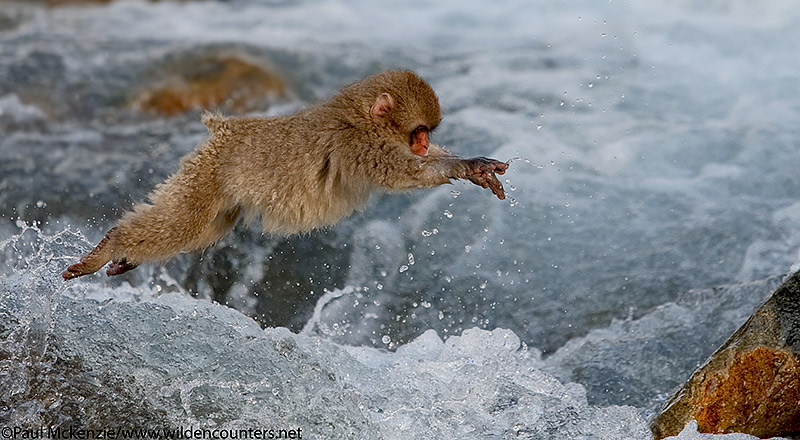
Juvenile Japanese Macaque jumping across river, Jigokudani, Japan
By late February the sun is sufficiently high at midday that it covers an entire snow-covered slope on one side of the river. Grain is periodically dispensed onto this hill and the Monkeys happily take advantage of both the food and the warmth provided by the sun. I took several images over the course of the second trip and here I got lucky with the monkeys evenly dispersed and with minimal overlap.
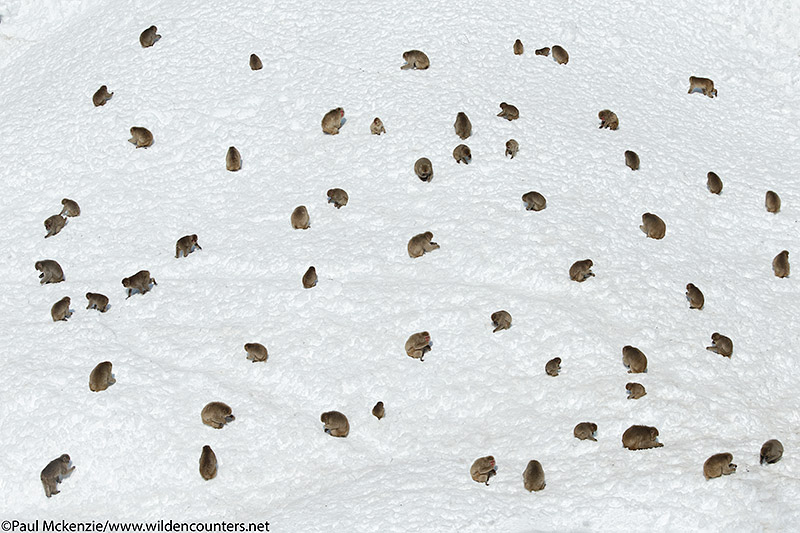
Japanese Macaques foraging on sun-covered snow slope, Jigokudani, Japan
While the Monkeys are clearly the main attraction at Jigokudani, there are other photographic possibilities if one looks a little harder. For the first image a tripod was essential with a long shutter speed required (1/8th sec) to slow the movement of the water but one that was not too slow to lose all of the detail.
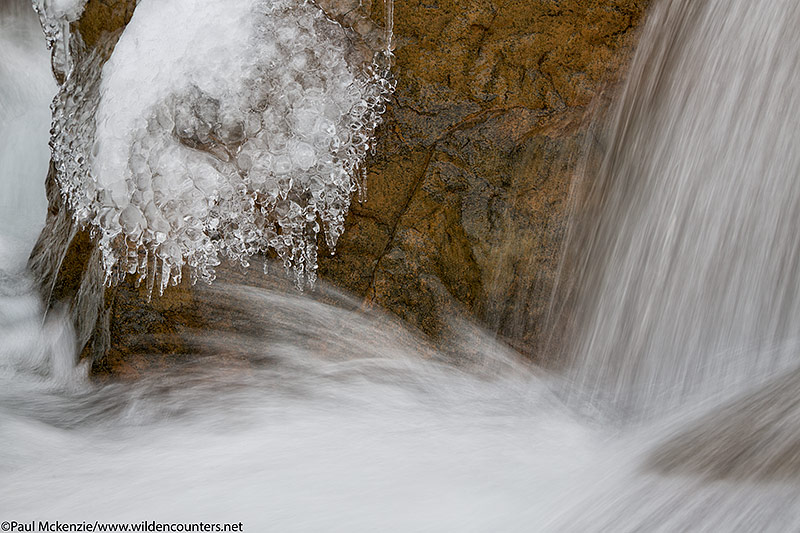
Water flowing past rock and ice, Jigokudani, Japan
I noticed the snow patterns below as I was leaving the park on the first day of the second tour. The light was low and the interplay between light and shadow was especially attractive. But I was cold and running late and a little lazy so I passed assuming that I would have the same opportunities the following day. Lesson #1 in photography. If you see an attractive image, take it as it likely will not last. Sure enough the next day the lighting conditions in both the early morning and late afternoon never approached those of the first day. I did my best and this is not bad but trust me when I tell you that the contrast was much more attractive on the first day.
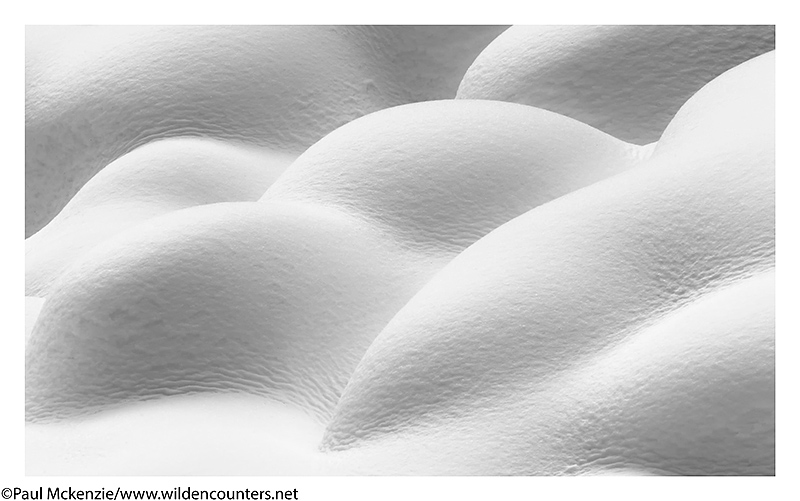
Snow patterns, Jigokudani, Japan
Kyoto – classic Japan
From Jigokudani, most of the group continued on to Kyoto via bus and high-speed train. Kyoto is what most people imagine Japan to be in their imaginations – colourful Shinto shrines, sublime Zen gardens, delicate plum and peach blossoms, quiet temples and narrow alleys down which geisha girls can be glimpsed. There are photo possibilities at every corner and even die-hard wildlife photographers rarely fail to be inspired.
But with millions of images already captured of the city’s iconic sites, the trick as always is to try and take something different and the following are an exercise in this pursuit.
We began the first morning, in the rain, at arguably Kyoto’s most visually arresting spectacle – the Fushimi Inari Taisha shrine. Thousands of Shinto orange coloured shrine gates line paths that criss-cross the mountains overlooking southeast Kyoto. And at one point these gates form a giant winding, orange tunnel. The first image is a fairly standard shot of this spectacular tunnel but even here, a little imagination was necessary as this is in fact, three images blended together, with the focusing slightly different on each in order to ensure foreground to background sharpness something that would be impossible even at a very small aperture given the 70mm focal length.

Tightly packed arcades of wooden, vermilion torii (shrine gates), Fushimi Inari Taishi, Kyoto, Japan
However, I much prefer this next image…
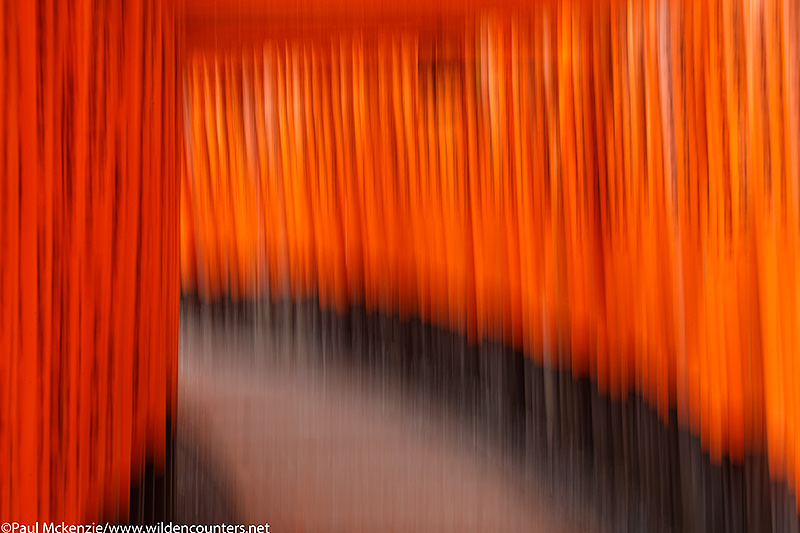
Vermillion Shinto shrine gates blur, Fushimi Inari Taisha, Kyoto, Japan
…but this is the really funky one. An in-camera, 5-frame, radial zoom blur: the acid tunnel.
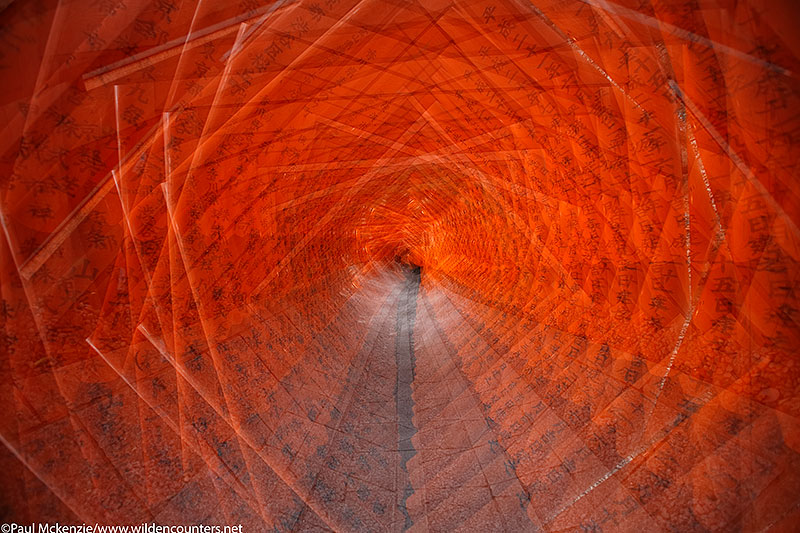
Radial zoom blur of the tunnel formed by shrine gates at Fushimi-Inari-Taisha, Kyoto, Japan
Although it was raining heavily, I decided to explore the entire 5kms shrine complex that snakes its way through the swirling mist to the top of the mountain. On the way down, my eye caught the single black character on this shrine gate juxtaposed against the rectangular monochrome steps in the background.
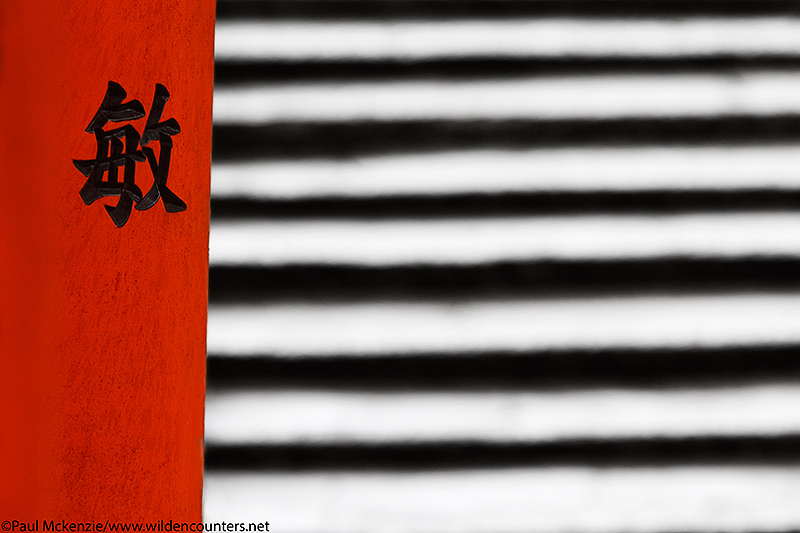
Shinto shrine gate with steps in the background, Fushimi-Inari-Taisha, Kyoto, Japan
The retina-burning Kinkaku-Ji temple bears some similarities to the more famous Golden Temple in Armritsar, India and when you arrive through the main entrance, this is the sight that greets you. While the overhanging tree branches are a nice twist, every single visitor to this site will have taken a similar image.
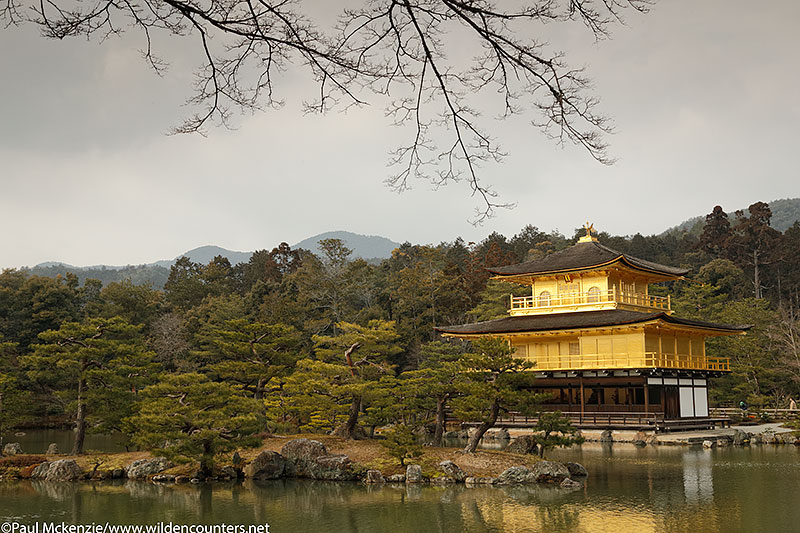
Kinkaku-ji temple, Kyoto, Japan
But few will have taken this much more original and imaginative image.
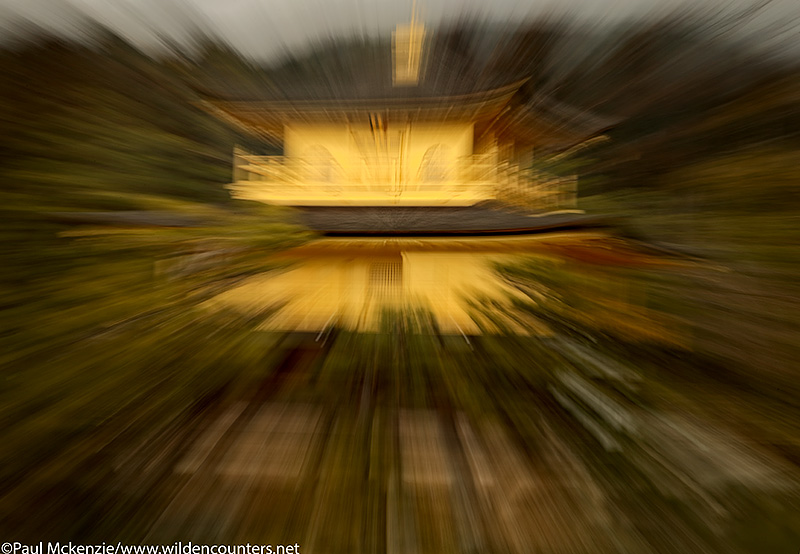
Zoom blur of Kinkaku-ji temple, Kyoto, Japan
Another of my favorite Kyoto spots where I took our group in the early morning on two consecutive days was the bamboo forest in the suburb of Arashiyama. Here’s a straightforward image using focus stacking to ensure front to back sharpness. It’s OK but certainly nothing special.

Bamboo grove, Arashiyama, Kyoto, Japan
This is a little more imaginative – the camera was on a tripod a few inches from the ground. A fish-eye lens was used to include as many bamboo stems as possible.
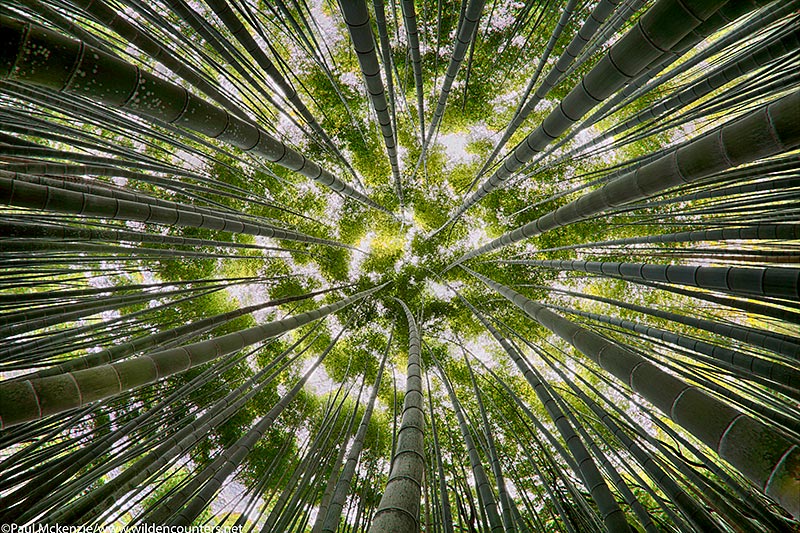
Bamboo grove fish-eye, Arashiyama, Kyoto, Japan
But this next image is the shot I was after and is without doubt my favorite image from the trip. The secret behind it was having been to this location before. I had taken similar images but never quite got it right. The key was finding a part of the grove that had several different shades shades of colour, zooming in to avoid all distractions and using a slow shutter speed while panning slowly in a vertical motion. But the most important ingredient was the use of a little fill flash. This helped to being out some of the detail in the bamboo while still retaining a sense of motion.
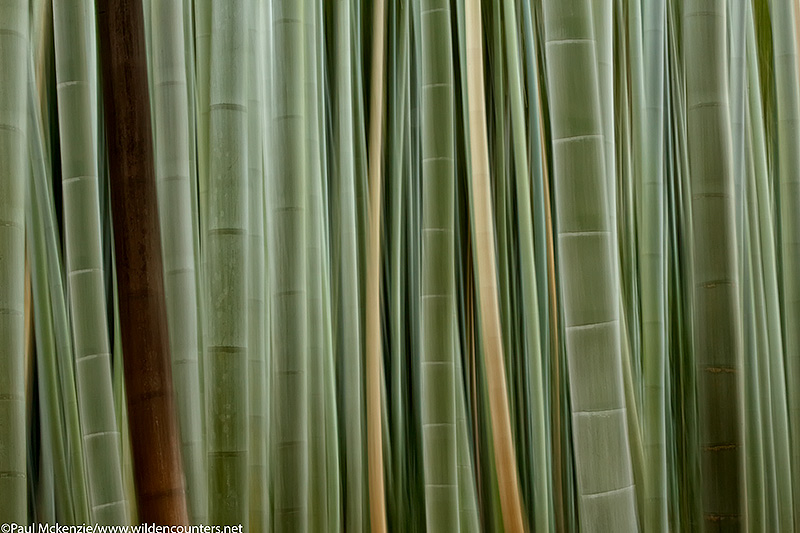
Bamboo forest, Arashiyama, Kyoto, Japan
The images shown here represent only a small portion taken on what was an enormously successful trip. The success of the trip would not have been possible without the amazing teaching skills of Arthur Morris and Denise Ippolito. But what really made the tour so enjoyable, for me anyway, was the excellent attitude displayed by all group members and the camaraderie that developed early on into the trip. Here’s hoping next year’s tour will be equally successful.

The group in Japanese evening wear, Yudanaka, Japan. From left: Malcolm Mckenzie, Denise Ippolito, Arthur Morris, Lex Franks, Srdjan Mitrovic, Alan Lillich, Debbie Franks, Pat Lillich, Zorica Kovacevic, Paul Mckenzie
Comments
- Japan in Winter 2018 Announced! | A CREATIVE ADVENTURE photography by denise ippolito - […] CHECK OUT PAUL’S JAPAN BLOG POST HERE. […]
Gordon Lindsay
May 19, 2014
Well worth waiting for Paul, I also follow BAA and read of the trip from Artie Morris, wonderful.
Paul Mckenzie
May 20, 2014
Artie’s a bit faster on his blogs than me!
Osvaldo Larrain L.
May 20, 2014
Hi Paul , wonderful images you have done , I will be waiting anxiously images from your next location .
All the best .
Paul Mckenzie
May 20, 2014
Thx Osvaldo. Still have to get back to Chile!
Denise Ippolito/A Creative Adventure
May 20, 2014
Paul, These are all fantastic. I would expect nothing less 🙂 Can’t wait for our 2015 Japan workshop together.
Adeline McComb
May 20, 2014
Awesome images once more! Looking forward to your next set!
Paul Mckenzie
May 20, 2014
Thx Adeline!
Rodolfo Patron
May 20, 2014
Wooow! Muy bonitas fotos!
As allways, your photos are awesome beautiful! Congratulations!
Lily, my daughter and sons are about to departure to SA, Namibia and Botswana. A family trip to celebrate 30 years of marriage and my 60th birthday!
Jaime Migoya
May 20, 2014
Amazing images, amazing technique and amazing locations. Congratulations Paul
Paul Mckenzie
May 20, 2014
Thx for your kind words. Much appreciated.
Rosemary Harris
May 20, 2014
Wonderful photos Paul, love the variety of subjects and it would be hard pressed to pick a favourite among them, well worth waiting for.
Paul Mckenzie
May 20, 2014
Thx Rosemary for your generous praise.
Richard Vernick
May 20, 2014
As you know, we were there just before you got there. I thought my pics were good until I saw yours. Fantastic job.
Paul Mckenzie
May 20, 2014
Hi Richie. Good to hear from you. Sounds like you guys had a great trip too.
Clemens Vanderwerf
May 20, 2014
Paul, it was worth waiting for. Good narrative and fantastic images. Very inspirational. Would have loved to be there with you guys, but will safe that for a future trip.
Paul Mckenzie
May 20, 2014
Hi Clemens. Yes we must try to do another trip together.
Frances
May 20, 2014
Thanks so much for sharing these lovely photos. The bamboo one is also my fav.
Paul Mckenzie
May 20, 2014
Thx so much for stopping by. Yup, the bamboo is the best one.
Yan verschueren
May 31, 2014
Dear Paul,
amazing dancing crane’s and fantastisch Steller’s sea-egalers I always enjoy your picture’s
I never can’t get enough Thanks Yan
Paul Mckenzie
June 3, 2014
Thanks Yan. Still hoping we can do a trip to Congo together!